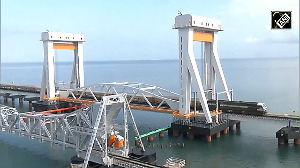Amidst the din of 'national calamity, catastrophe and river changing course', about two million people are facing forced submergence and displacement. The governments of India and Bihar are going about the relief work as if it is a favour they are doing for the people. That favour is being doled out in a totally haphazard, unplanned, callous way.
For immediate relief it is important that those being brought out from the waterlogged areas be given cooked food for at least two days. There should be planned settlements for such people, with arrangements for shelter, fuel, fodder, medicines, hygiene etc, as they are likely to have to stay at these places for up to two months. The affected people need not be considered as victims as is the case now, but should be involved in the whole exercise. Two million people cannot be resettled by outsiders. And in the comparatively lax law and order situation of Bihar, the responsibility of the state and the Centre increases considerably in ensuring dignified relief and resettlement.
In this effort, another very important aspect seems to be totally ignored. Most (about 85 per cent) of the 1.5 lakh cusecs (cubic feet per second) of Kosi water is flowing through the breach in the embankment that started with a small, few metres-wide breach on the eastern side, 12.9 km upstream of the barrage in the afternoon of August 18. This water is flowing through three of the 15 old streams of the Kosi river, namely Sursar, Mirchaiya and Belhi, says Dinesh Kumar Mishra, possibly the most well-informed person in India on Bihar floods, from his camp at Khagaria. This water is entering an area that does not have the capacity drain so much water.
Vijay Kumar of Nagrik Pahal, Patna, says an urgent assessment is needed to identify the bottlenecks in the drainage of this water into the Kosi river at Kursela, and assess what viable steps are possible to remove those bottlenecks. For, the longer the water remains in this zone of flooding, more damaging would it be for the people and the state. Similarly, it is important to ensure that the Kosi is able to drain out its water into the Ganga. But the Ganga has been flowing above the danger mark at Sahibganj (Jharkhand) and Farakka (West Bengal), as per the Central Water Commission's (Government of India) flood forecasting site for almost two months now and is further rising. Efforts would have to be made to see how this can be reduced.
Coming to how this all started, let us look at some facts. The barrage on the Kosi river, just before it enters India in Supaul district of Bihar from the upstream Sunsari district of Nepal, was built under the 1954 Indo-Nepal Treaty. The responsibility for the proper operation and maintenance of the barrage and the 22-km long embankment on both sides of the river is the Government of India's. In the afternoon of August 18, when the embankment breached, the flow of water was about 1.44 lakh cusecs, when the embankment and the barrage are supposed to have a designed capacity of 9.5 lakh cusecs. The fact that the embankment breached at such a low flow compared to the design capacity speaks volumes about the silt accumulation on the Kosi riverbed and about the abysmal state of maintenance of the embankment. The statement from the Indian embassy in Kathmandu that Nepal did not cooperate in ensuring timely maintenance is adding insult to the grave catastrophe.
The monsoon in this part of Bihar starts in early June. And the repair and maintenance of the embankment is supposed to be completed before the onset of the monsoon. So it is clear that firstly, the maintenance be done by the required date and the Government of India could have ensured, at least for the sake of the two million people of Bihar and Nepal in the risk zone, that all measures were taken to ensure timely maintenance was done by June. That was not done.
Moreover, the pressure on the breached site on the embankment was apparent from August 5 onwards. Even at this stage, if the Government of India had used all its powers to ensure proper maintenance, the disaster could have been averted. That too was not done.
When the news of the breach broke on August 18, the governments in Delhi and Kathmandu could have woken up to see that the water flowing out of the breached portion cannot re-enter the Kosi river since the river is embanked at least 135 km downstream from the site of the breach. That water was bound to take the path of least resistance, and the possibility of it going into the old Kosi streams was the strongest. However, neither government woke up even on August 18.
Thus, precious time was wasted. If the government had woken up on August 18, then a more planned evacuation was possible and most of the lakhs of people marooned today would not be there. It is clear that there has been a series of grave and criminal blunders that have led to this disaster of huge proportions. The trouble is, even now we do not know who people are whose neglect caused this disaster, and going by our track record we may never know who they are.
Among other things, the prime minister after visiting the area declared that resources would be made available to repair the breach in the embankment. The government may even succeed in doing that and bringing the Kosi back to its pre-August 18 course. But we must remember that the bed level of Kosi all along the embanked portion of about 150 km has risen, and there is no way this embankment strategy can go on for long. The frequency of such disasters would only increase in the years to come.
The option of the proposed big reservoirs is also a false hope. According to the documents prepared right in 1937, when the big storage reservoir on the Kosi was proposed, that dam would silt up in 37 years, keeping in mind the silt carried by the river. By now the catchment is further degraded and the proposed dam would silt up in even less time. No economically viable strategy for desilting the river or the reservoir is available. So this is completely false hope.
So the perennial questions that the nay-sayers face: What is the alternative?
Firstly, the government's notion that floods equals disaster would have to be given up.
Secondly, the water that flows through the Kosi does not fall on that river. It is the accumulation effect of rainfall and glacier melt along the whole of its huge catchment. That catchment would have to be treated at micro and macro levels. Wetlands, forests, local water systems, aquifers would have to be protected, their destruction stopped, and additional capacities created where possible.
Else, we might remember what Nepal Prime Minister Prachanda said after a visit to this area, one of his first tasks as PM, that the Indo-Nepal Treaty of 1954 was a historical blunder. That phrase actually applies to the whole embankment strategy.
Lastly, those calling the Kosi as the sorrow of Bihar need to know that the people living along the Kosi do not consider it their sorrow, but as their mother and worship the river like their mother. This rather stupid phrase was possibly coined by a British tax-collector who found it difficult to collect his quota of revenue from this area. Is it not high time we stopped using the colonial phrase for a river?







 © 2025
© 2025